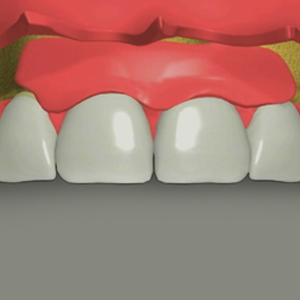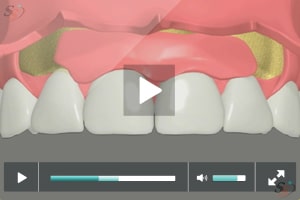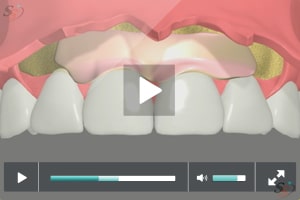Gum Grafting
Gum recession:

Gingival (Gum) recession can occur as a result of periodontal disease, orthodontic treatment (braces), grinding or clenching, trauma from lip and tongue piercings, and as a result of tooth brush trauma (heavy brushing). This can cause exposure of the root surface of the tooth which can look less than ideal, allow the teeth to become sensitive, and can make the teeth difficult to clean which could predispose to further recession. In a lot of cases, a gum grafting procedure can be done to reduce or completely cover the area of recession. A gum graft thickens up the tissue which can reduce the risk of further recession and bone loss, allow easier cleaning, and cover the area of recession, which can reduce tooth sensitivity, risk of decay and esthetic problems. There are many techniques available, and your periodontist will use one that is best suited for your type of recession.
Free Gingival graft
When the tissue has recessed quite a lot, and the firmer, pinker, thicker ‘keratinized tissue’ is lost, a Free Gingival Graft is normally used. To increase the amount of this thicker, firmer tissue, a piece of gum tissue is taken from the roof of the mouth and transplanted to the area of recession. Over the course of a month or so, this tissue attaches to the gum in the area of recession and provides a thicker and firmer area of tissue that can be less prone to more recession in the future. To completely cover the area of recession, sometimes a second procedure is needed to completely move the gum up to cover the recession.
Connective Tissue graft
When there is still some keratinized tissue around the area of recession, a Connective Tissue graft can be used to thicken up the tissue and cover the area of recession. The connective tissue is the collagen rich layer of gum tissue that sits directly underneath the surface of the gum. Usually in the roof of the mouth, the top layer of gum tissue is lifted out of the way and the underlying connective tissue layer is exposed and removed. The roof of the mouth is then stitched back closed. The connective tissue is placed over the area of recession and in the same procedure, the gum is moved up to cover the connective tissue graft and the area of recession. This creates thicker tissue that may be less prone to further recession, while also covering the exposed tooth root.
Acellular Dermal Matrix
When there are multiple areas of recession in an area of the mouth and there is not enough natural tissue in the roof of your mouth that can be used, an acellular dermal matrix is used. An acellular dermal matrix like a collagen sponge, and is the collagen structure from human skin but without the skin cells. Skin from tissue banks are processed to remove all human cells leaving only the thick collagen layer. This layer can then be used similar to a connective tissue graft to cover the areas of recession. While a separate surgical site in the roof of the mouth is not needed, this type of graft does not contain any living cells and can take longer to heal. It can also be more prone to infection if the post-operative instructions are not followed.
Post op instructions
Following your recession surgery, it is important that you do not eat any hard foods (preferably liquid or mushy food) for the first 2 weeks to a month. You will also not brush the area, instead using a mouth wash called Peridex to keep the area clean. It is also important that you resist the urge to pull your lip down to look at the graft. This is to ensure that you do not loosen any stitches or dislodge the graft while it is healing, as this could cause the graft to fail or become infected. You will be given an extra soft tooth brush, however you will not use this brush until your Periodontist has advised you how and when to it is save to do so.
Related Videos






